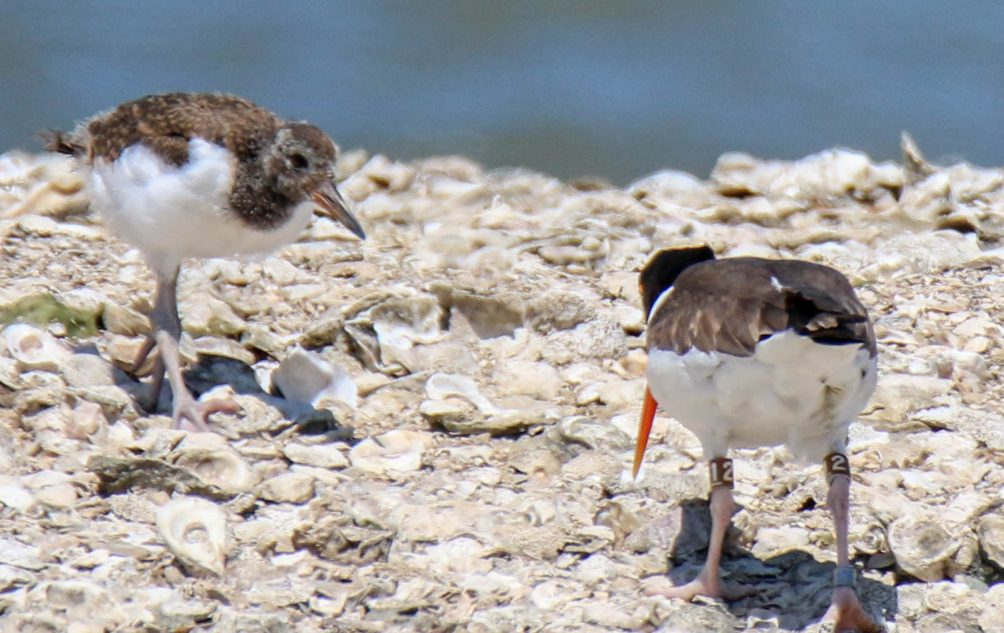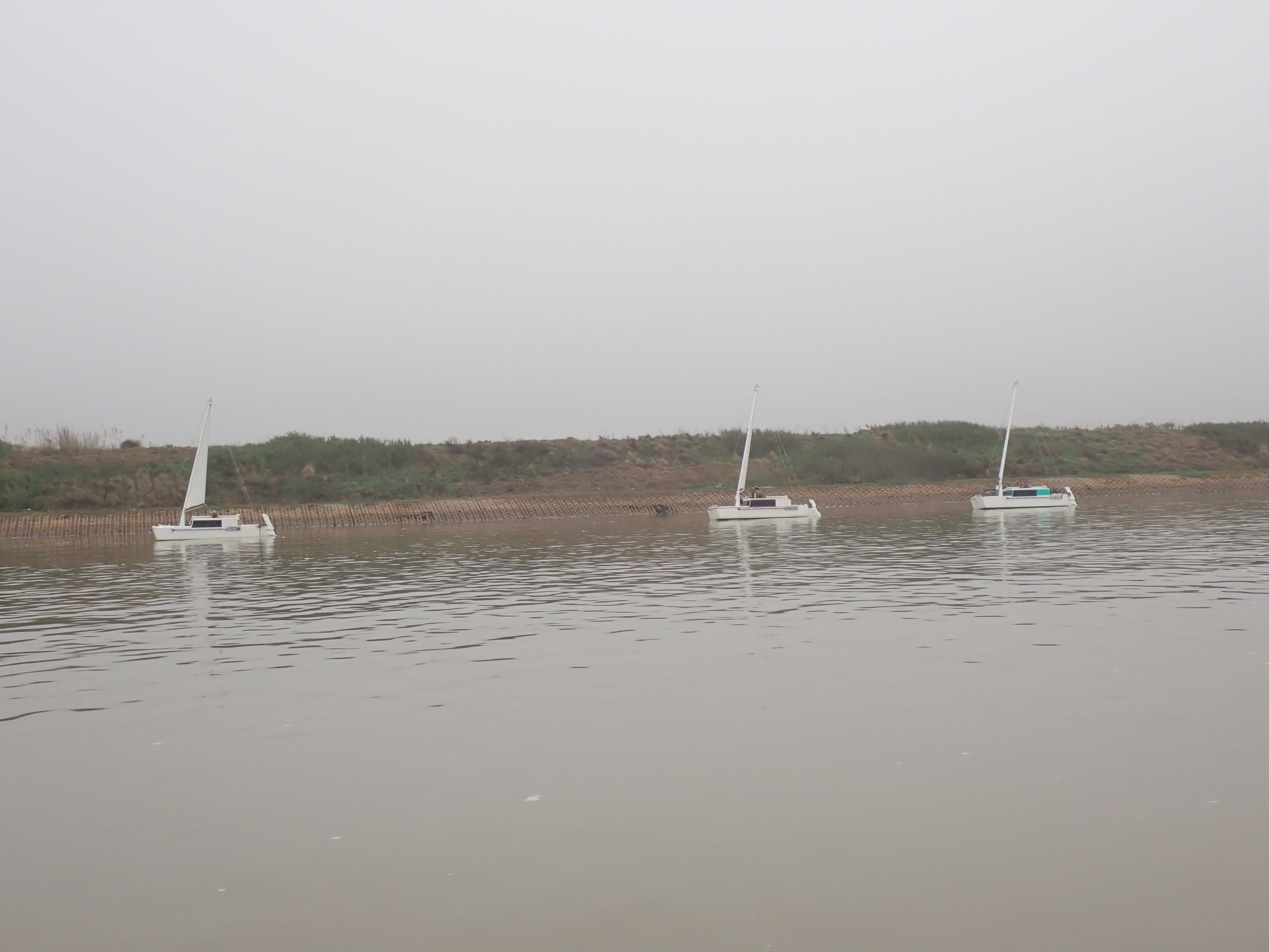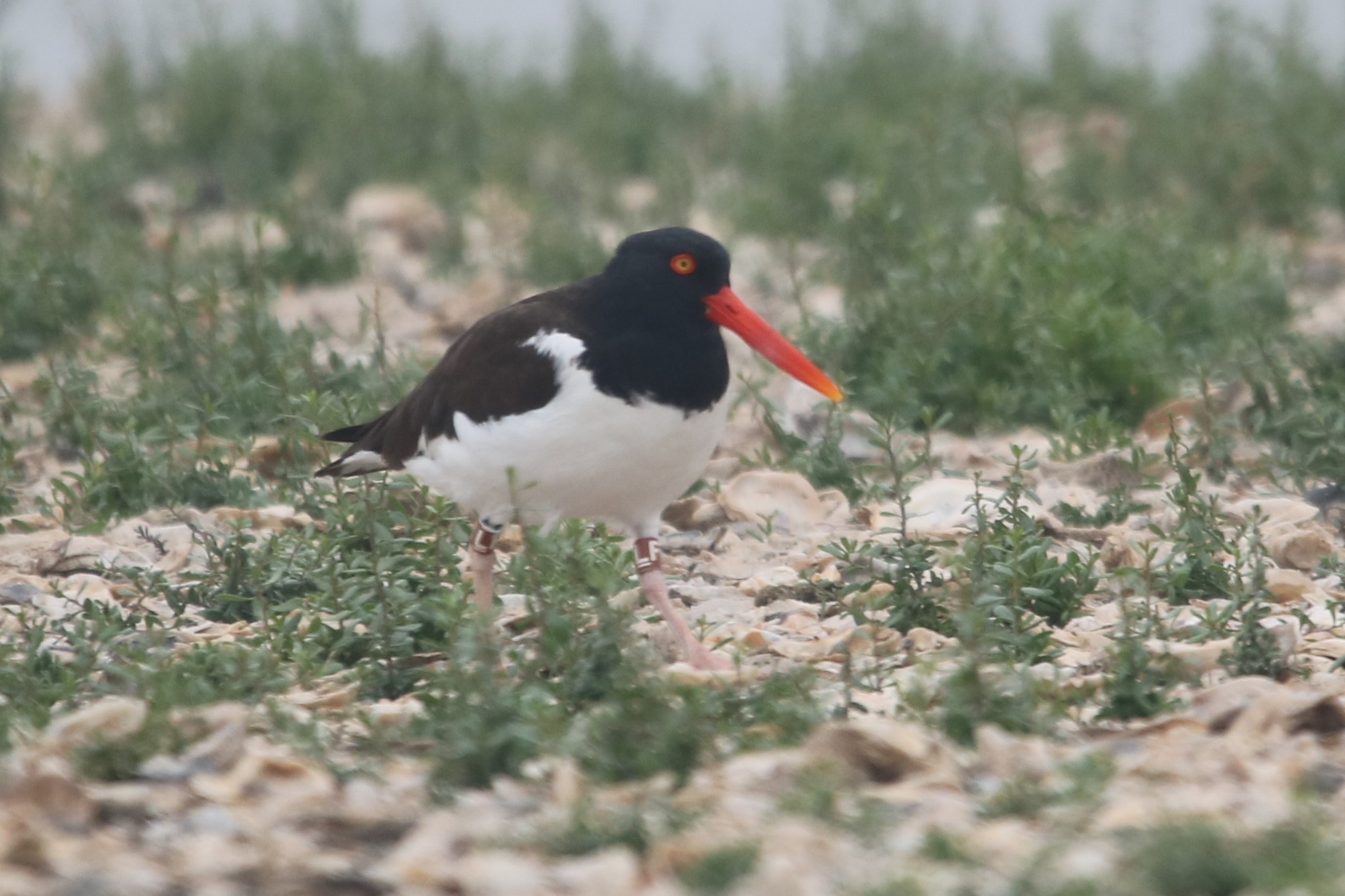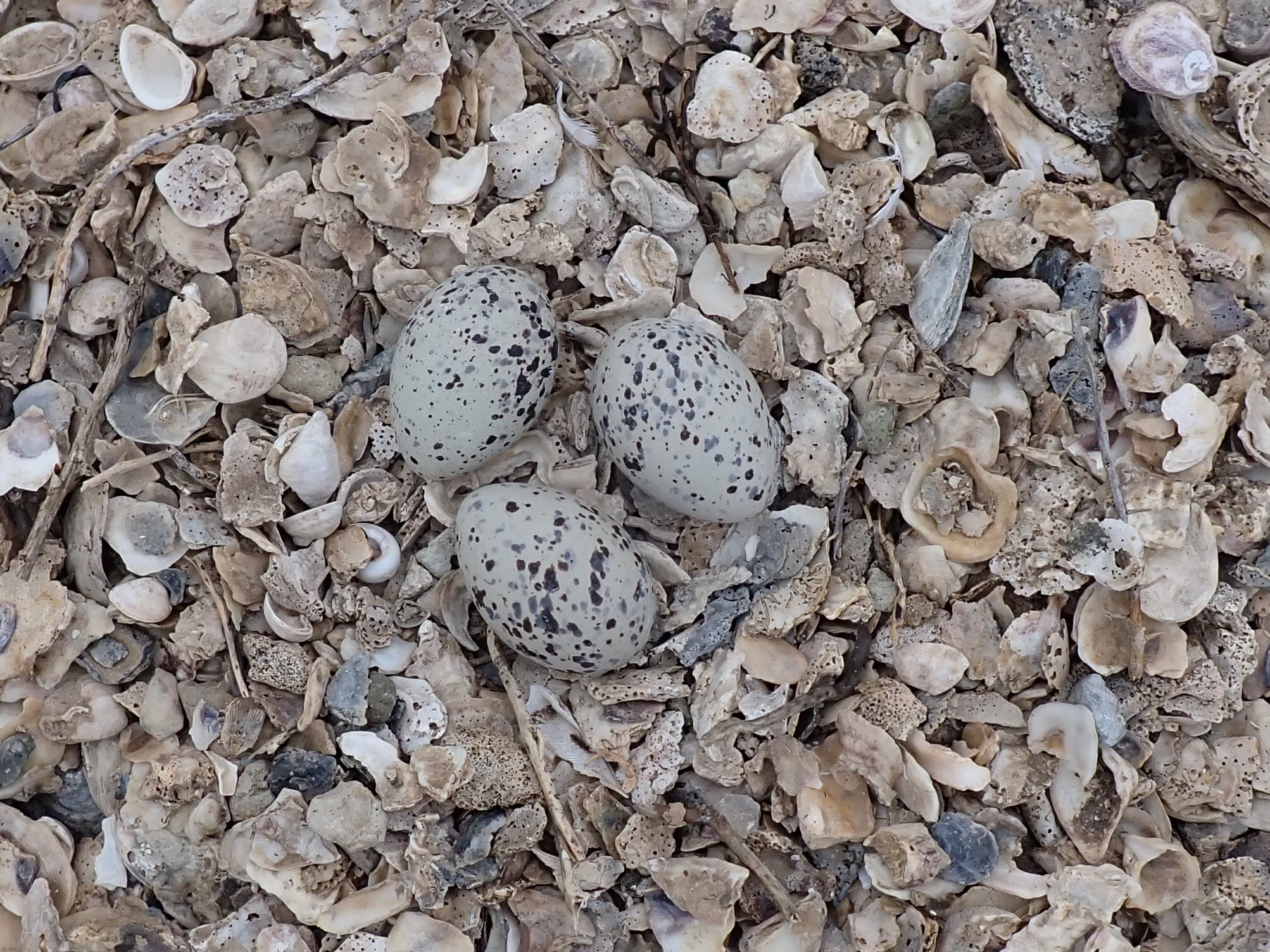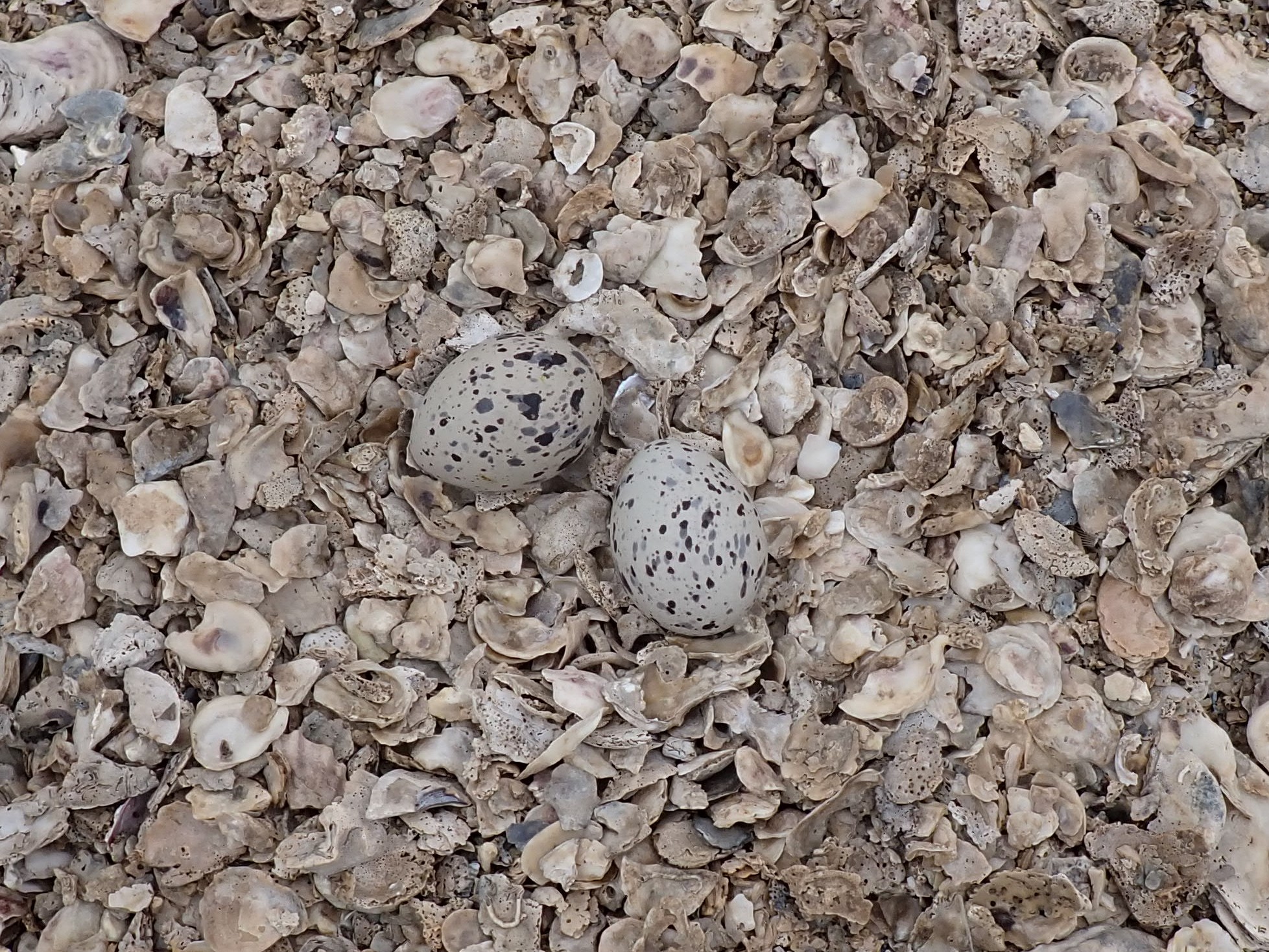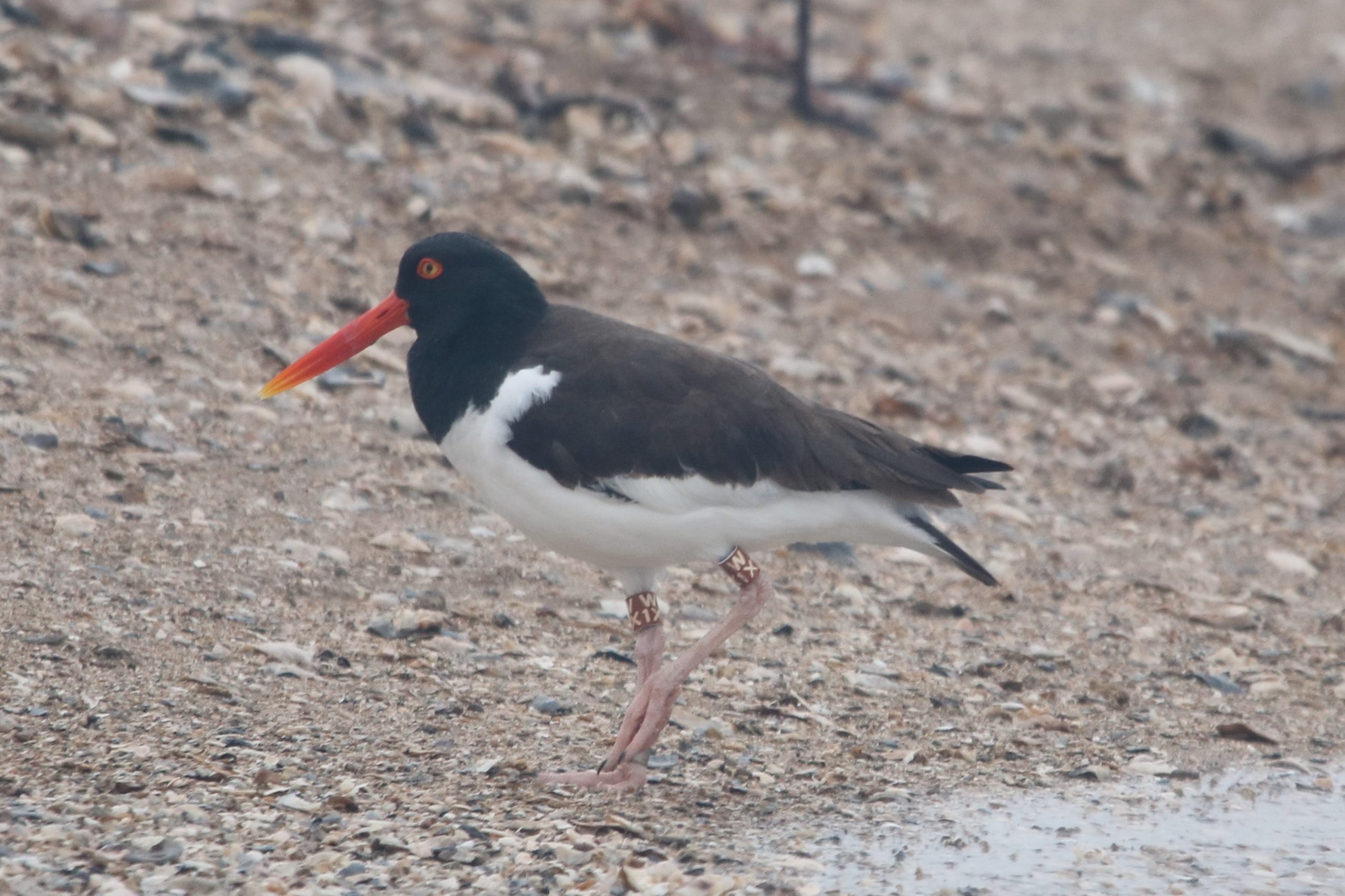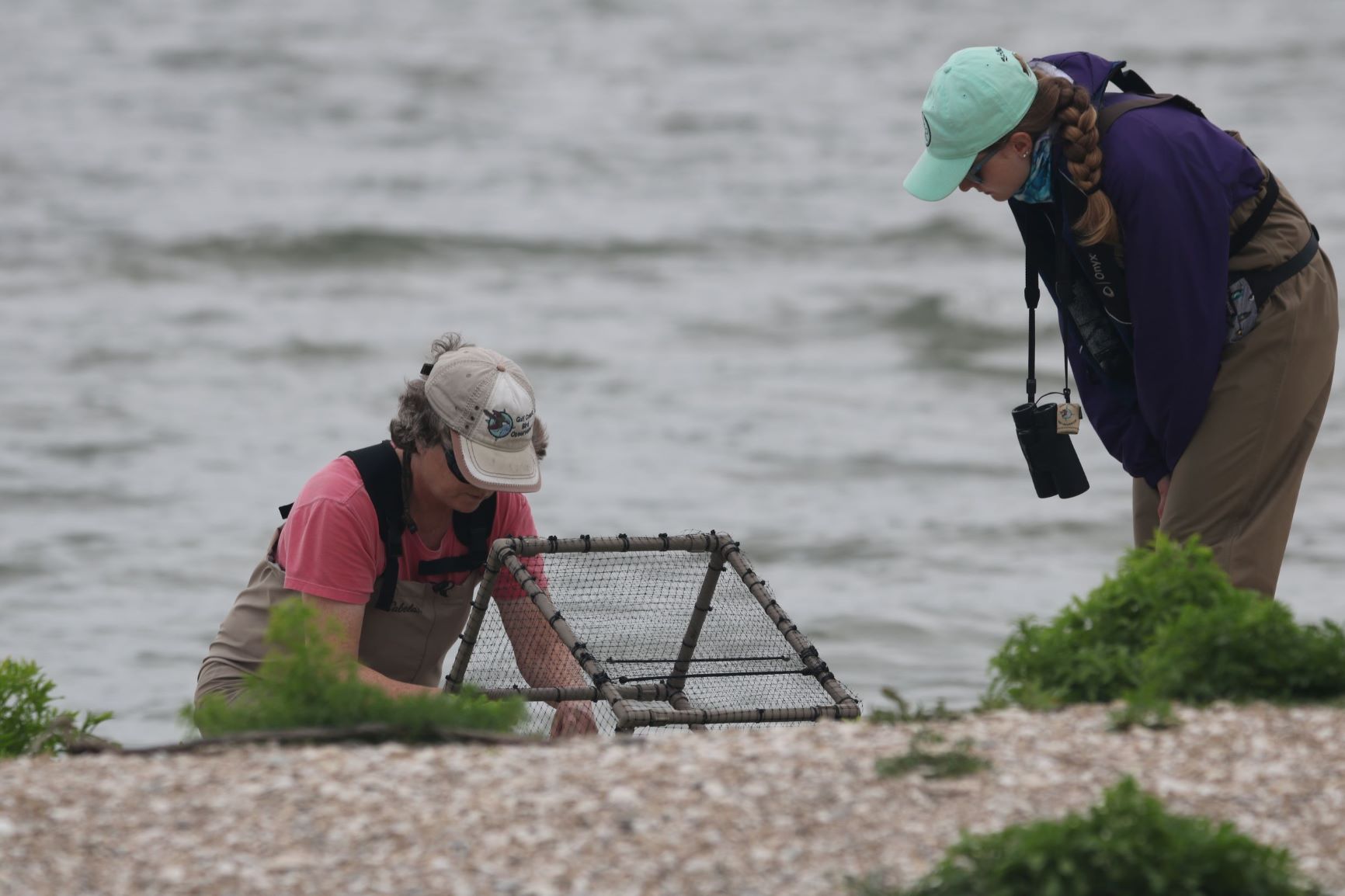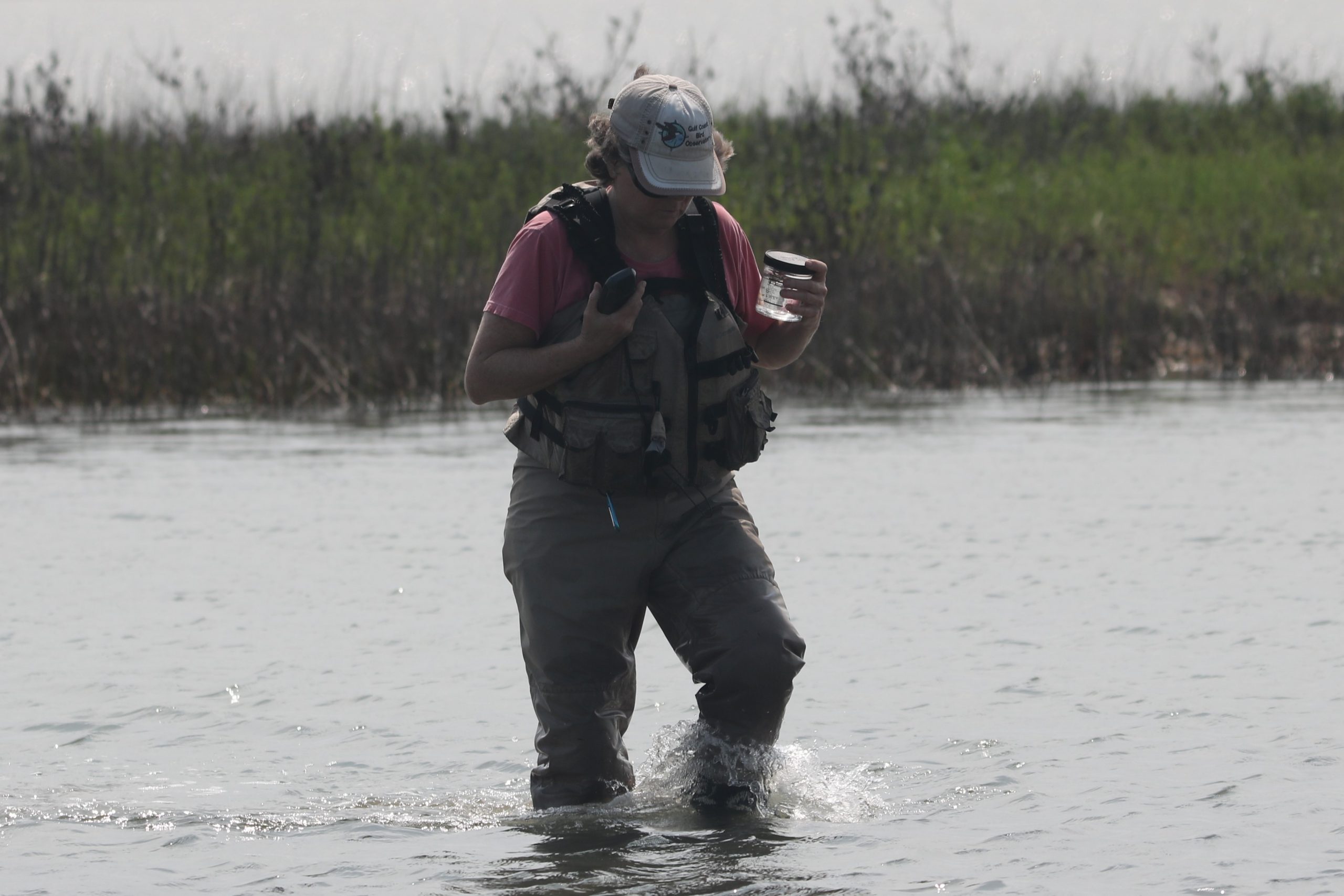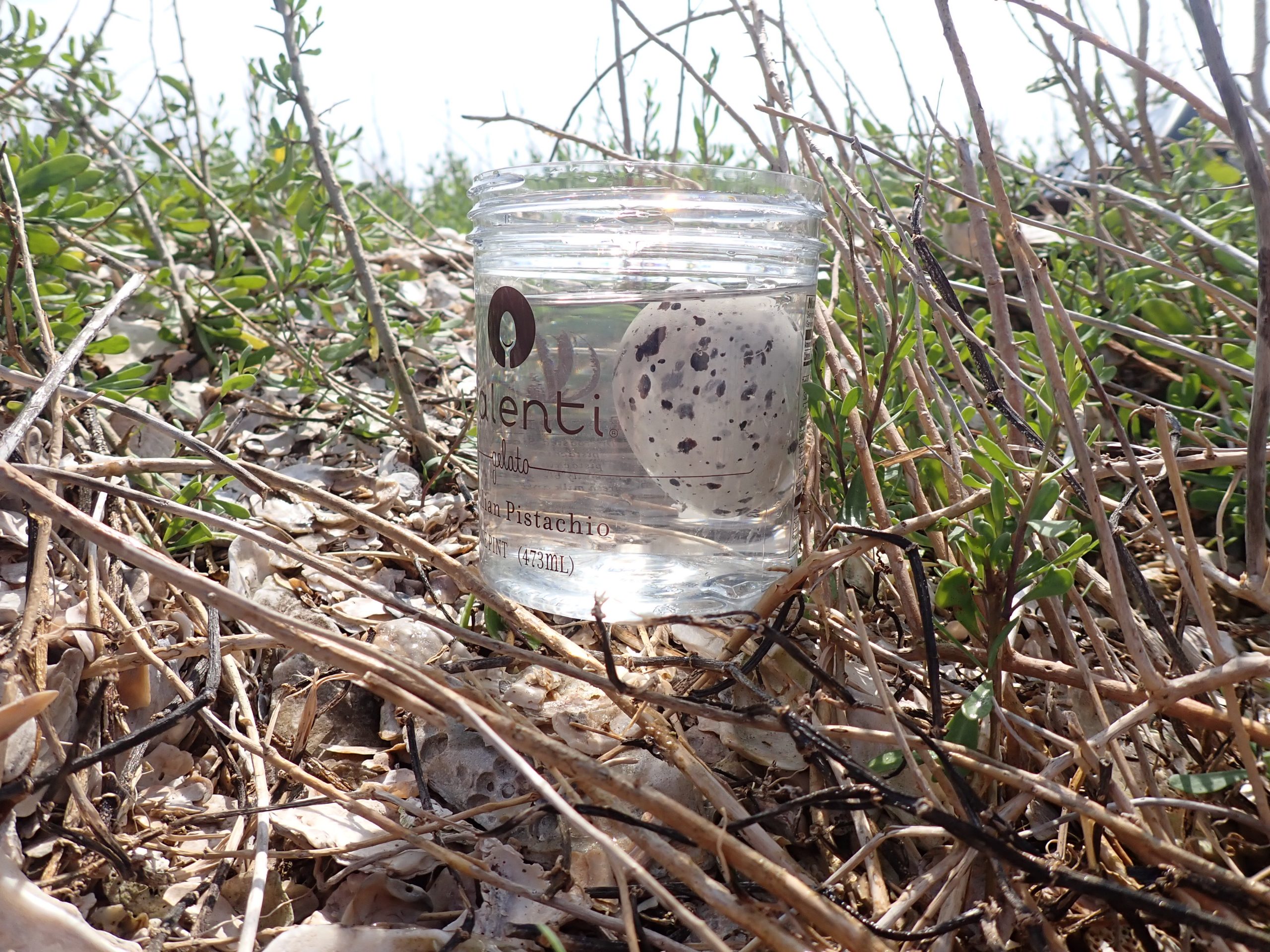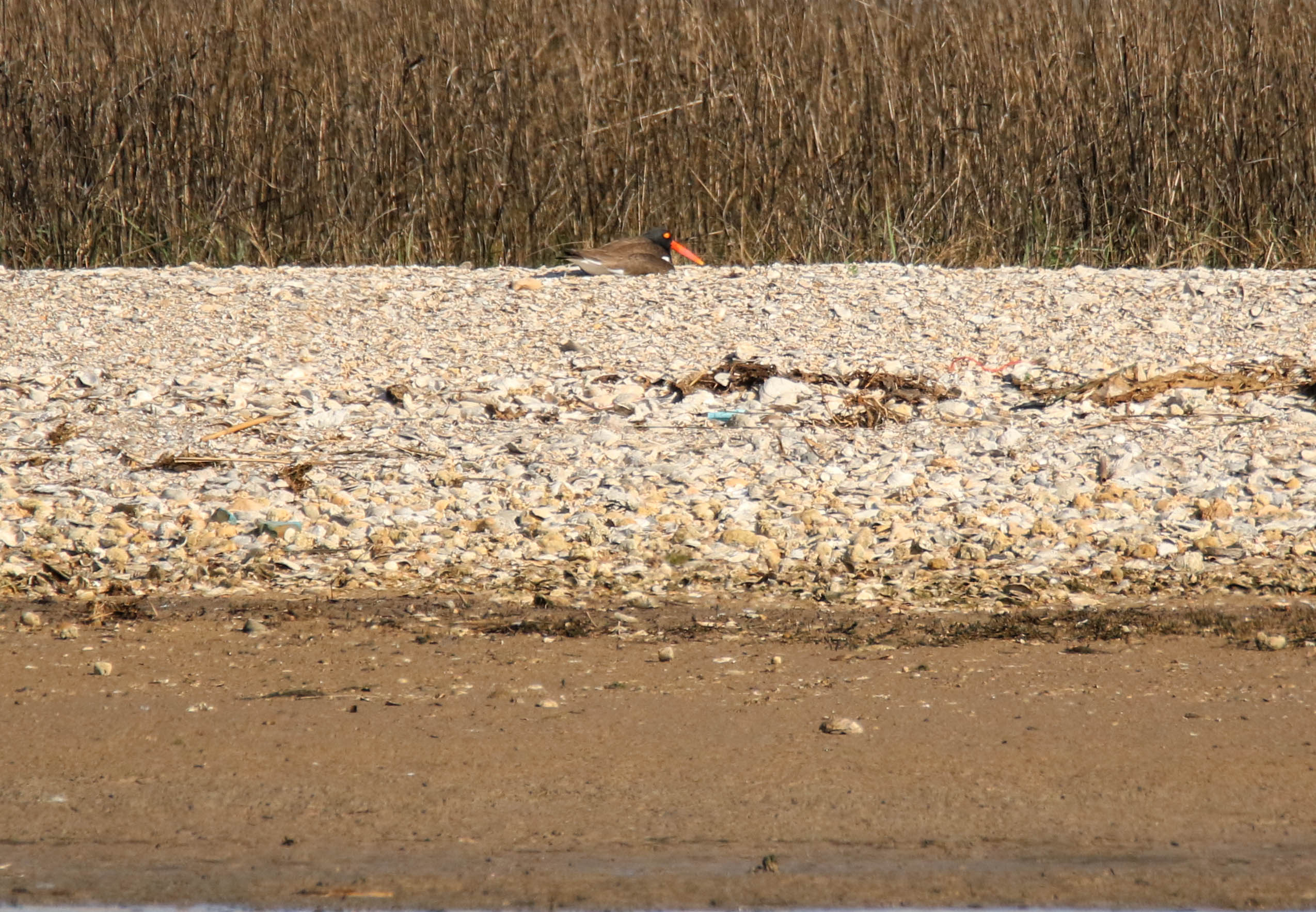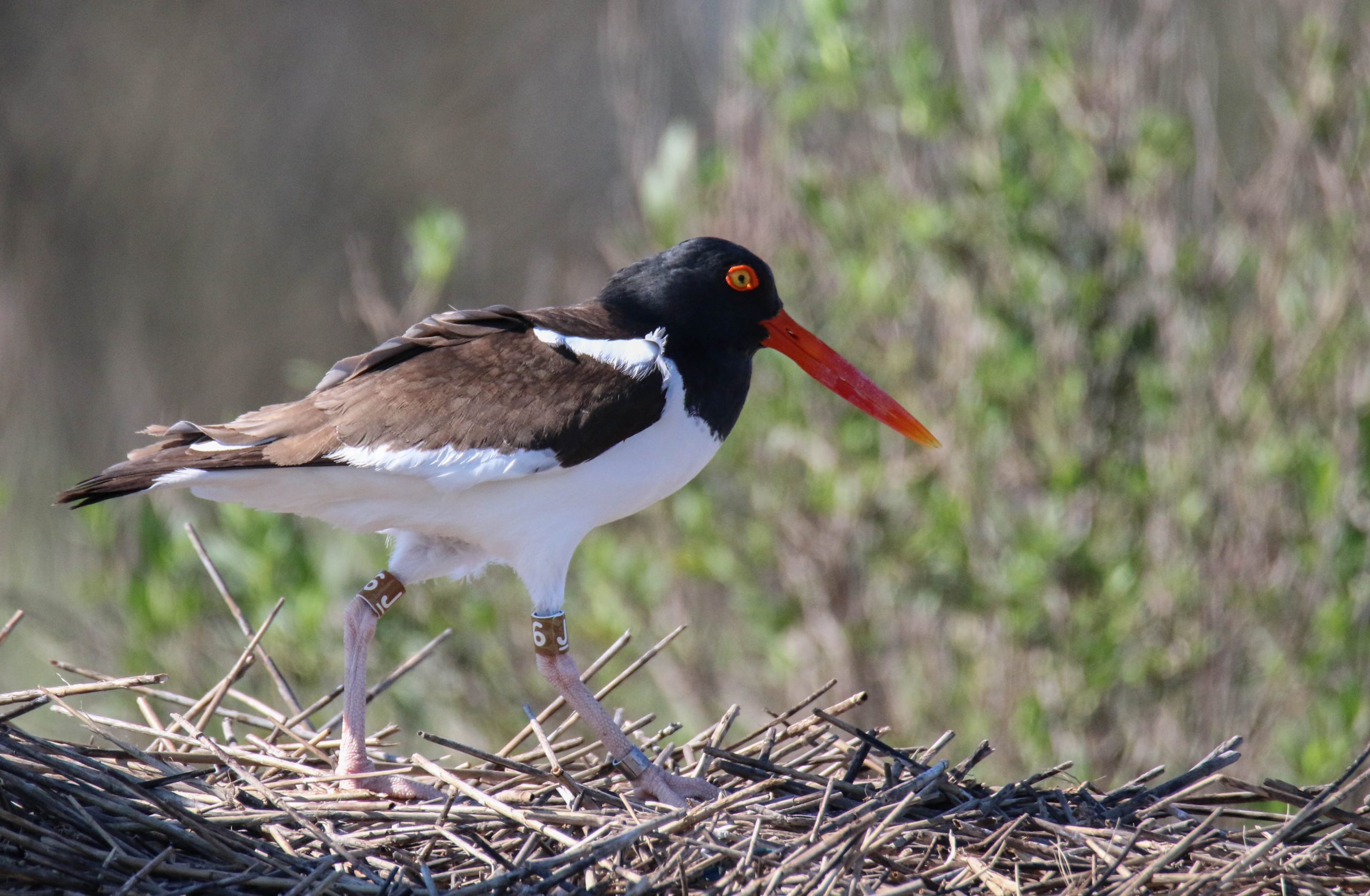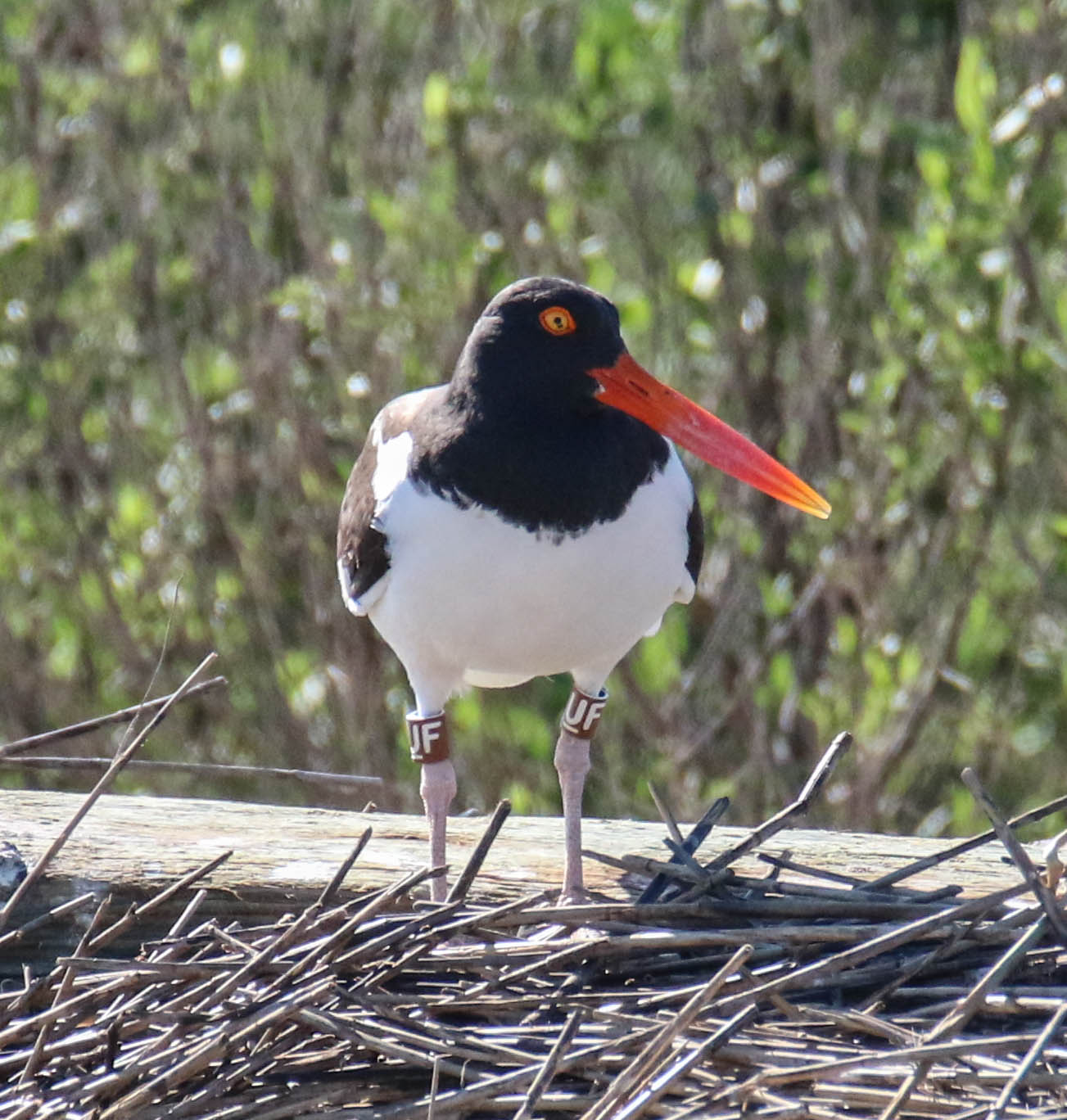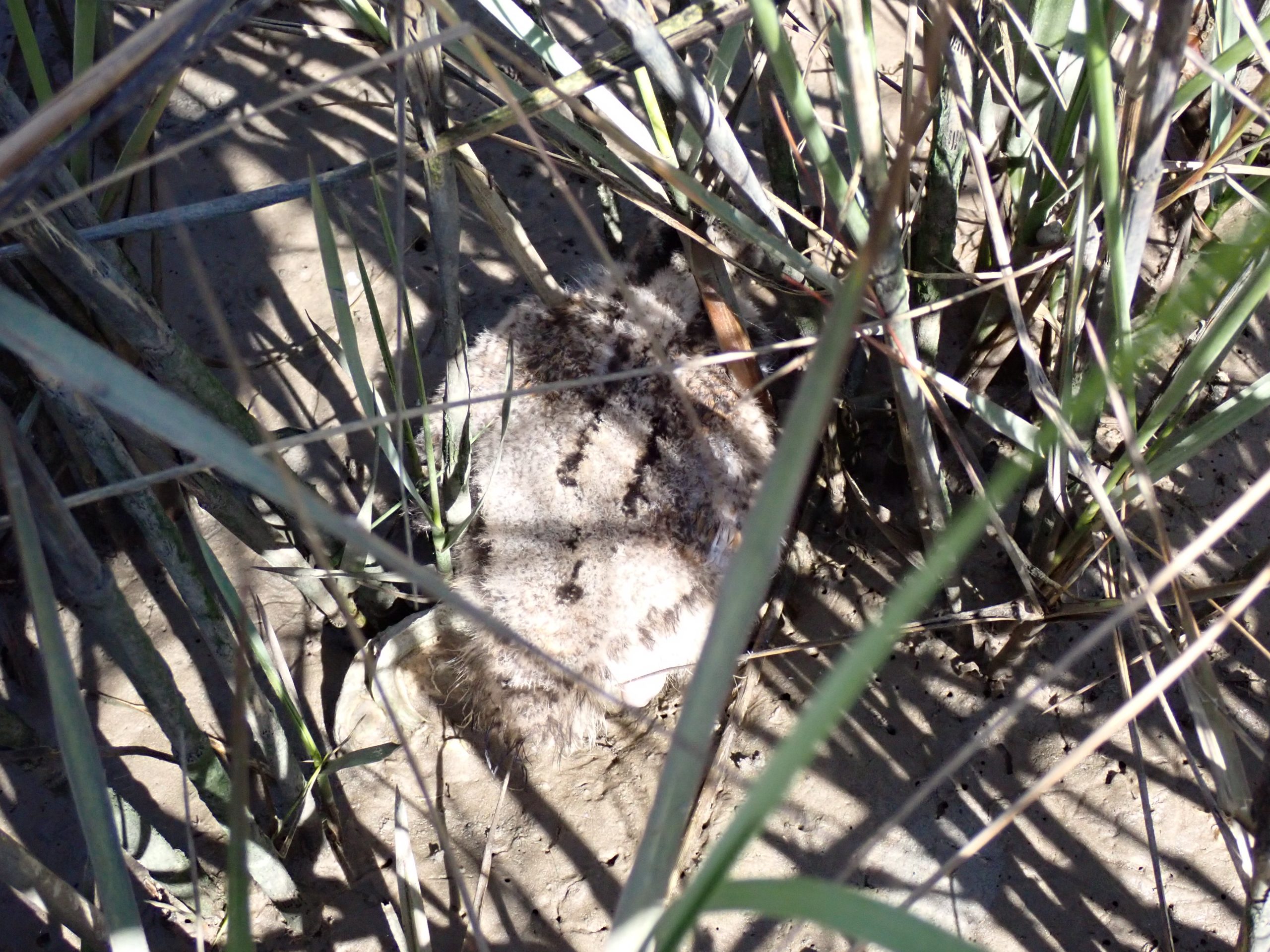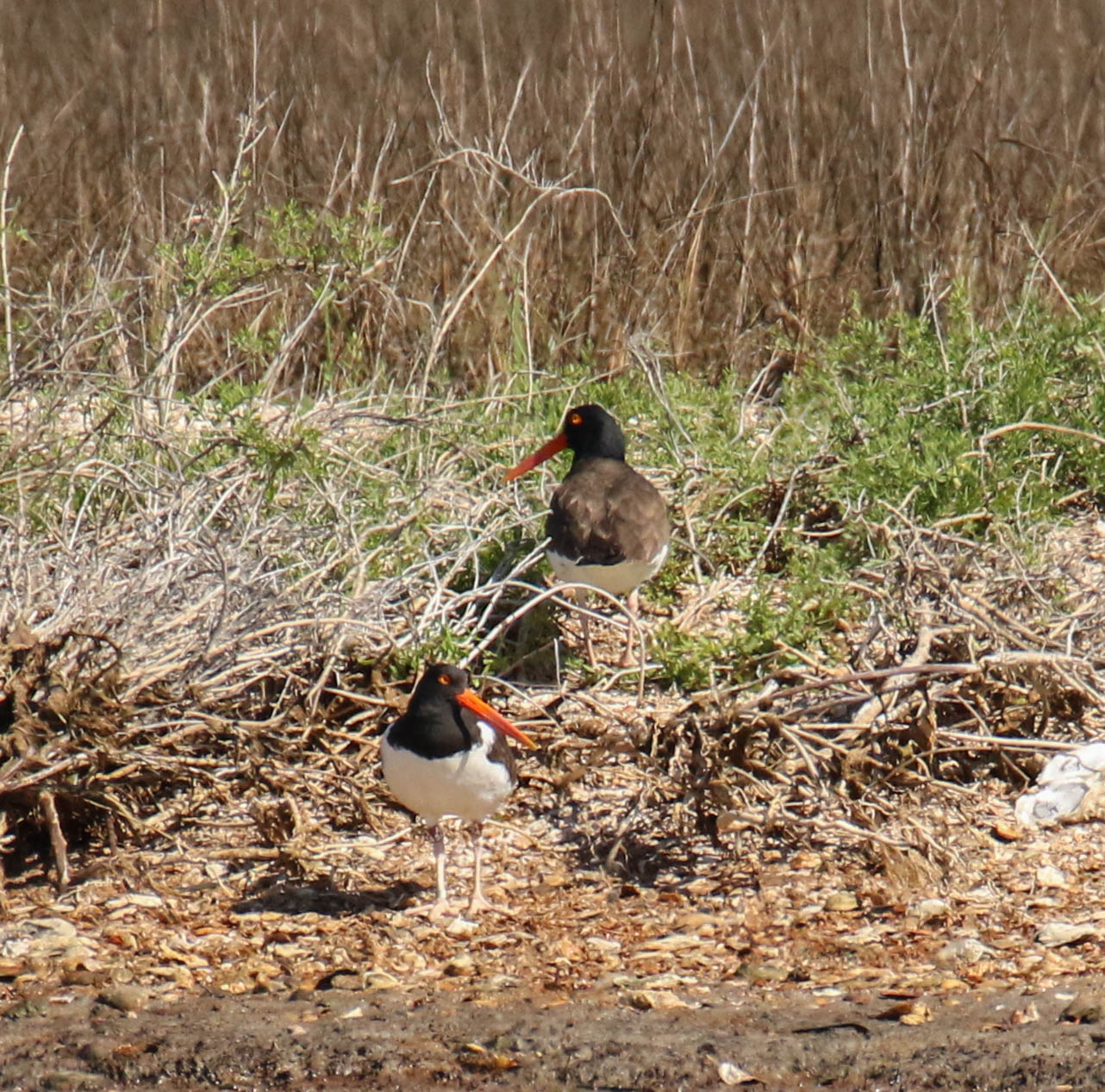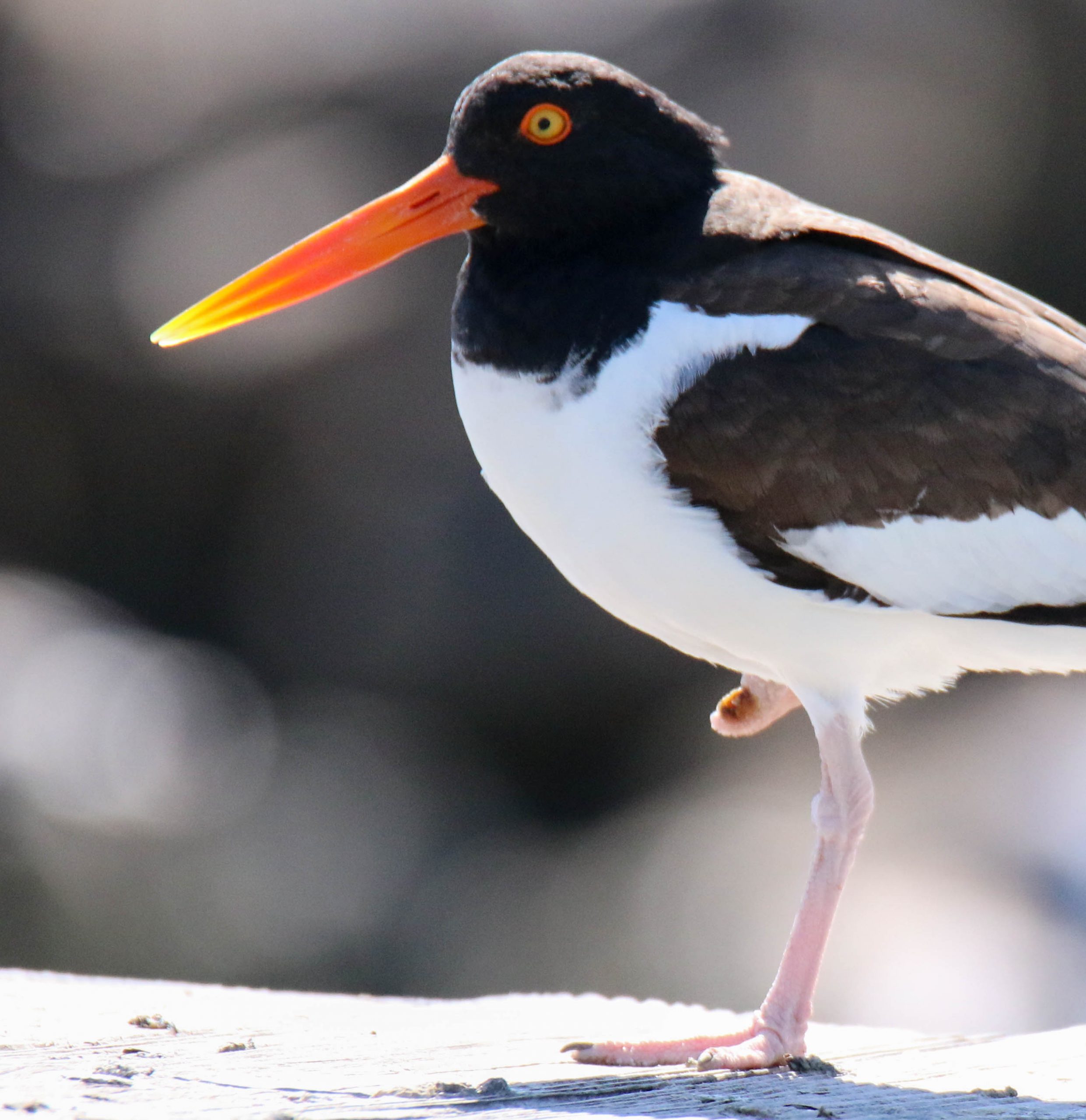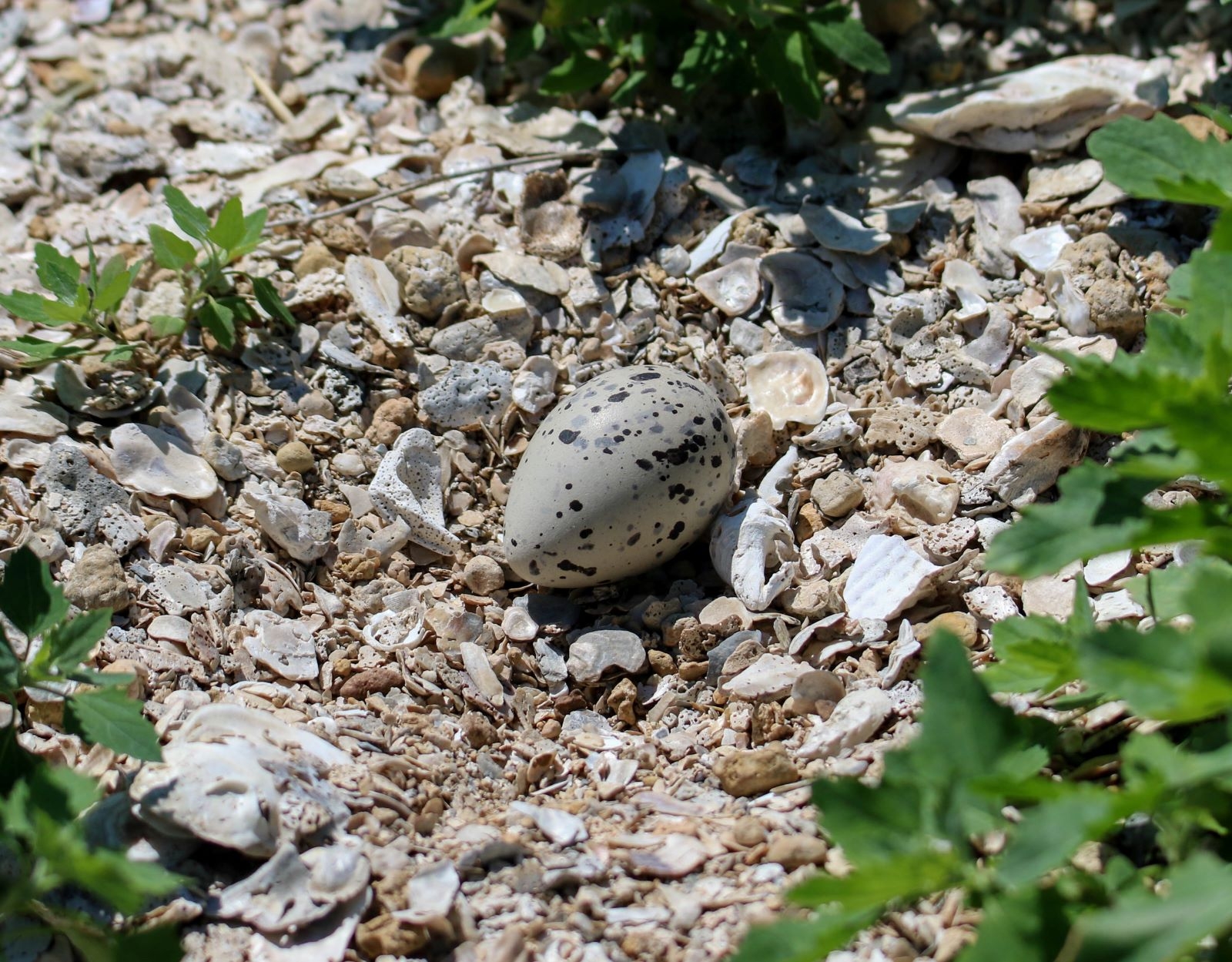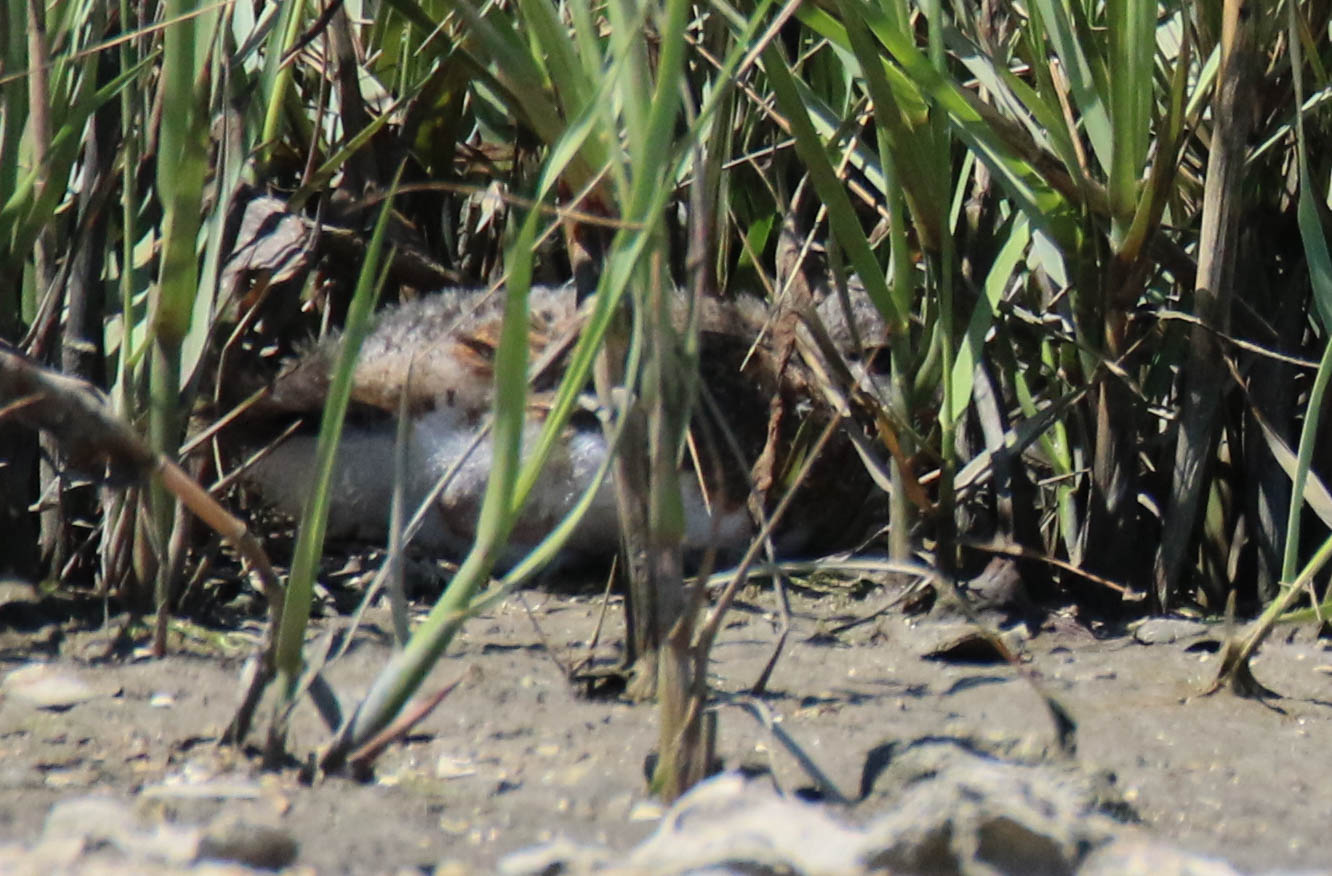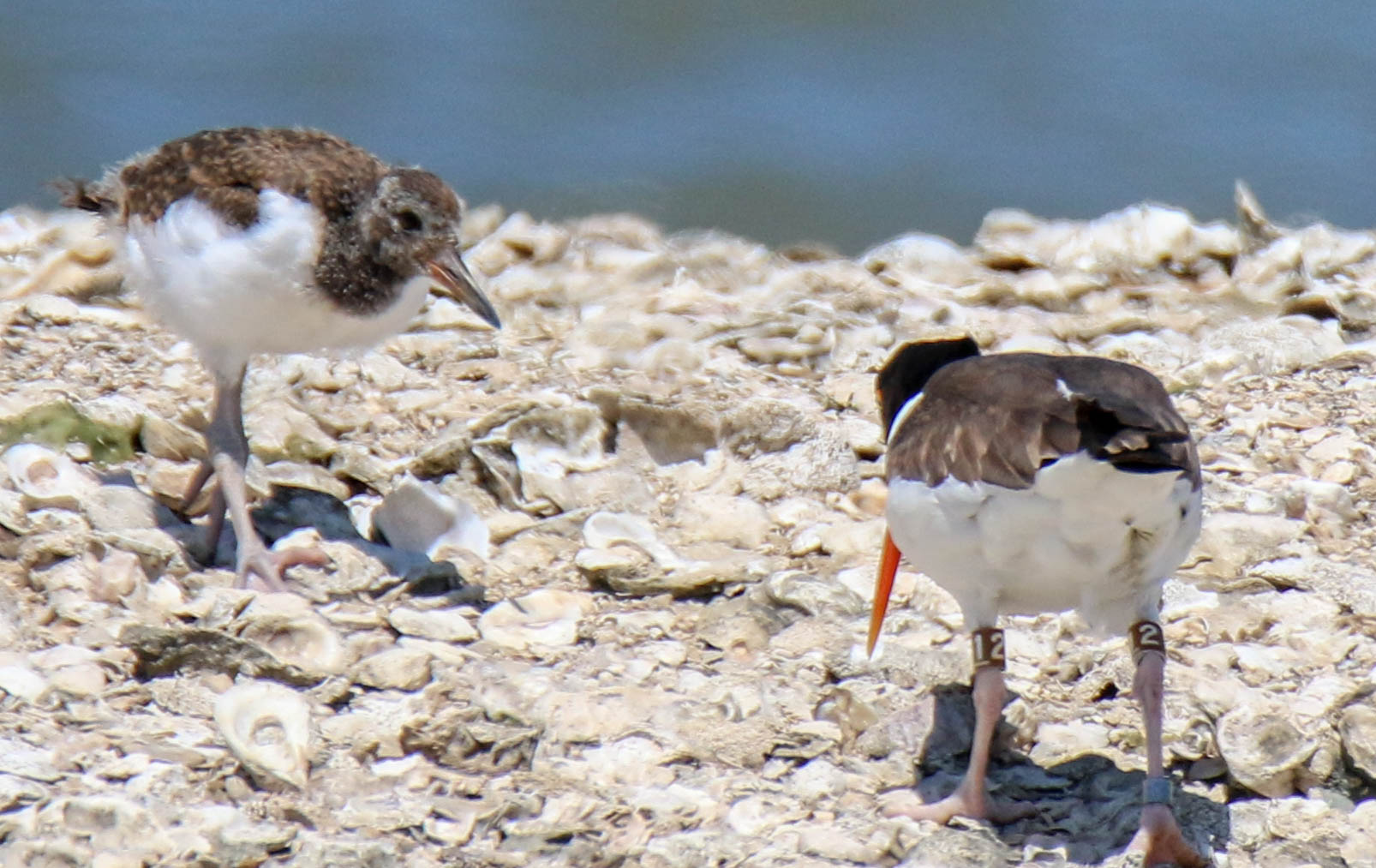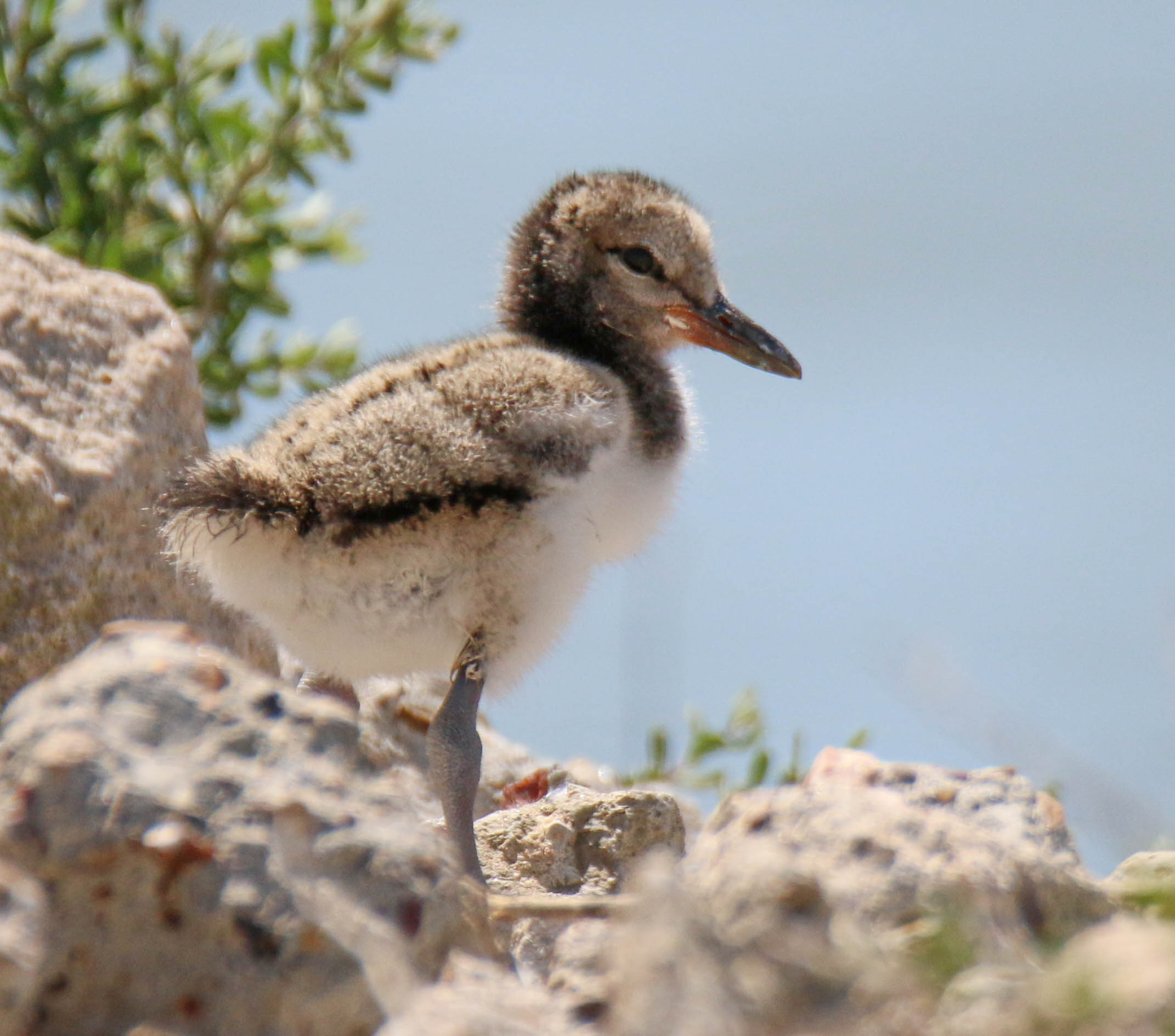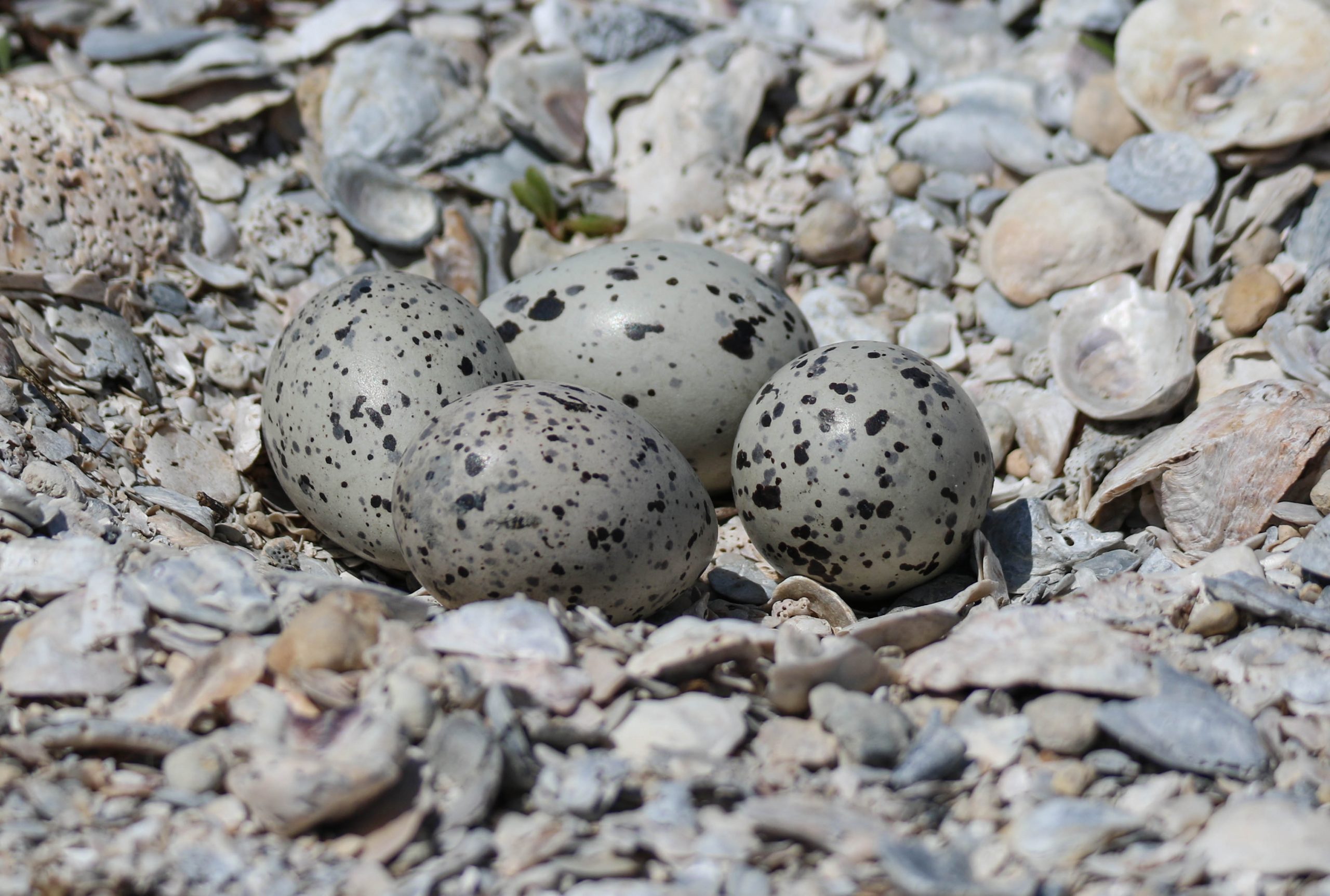By Susan Heath
It was a busy week with the oystercatchers! On Monday, Taylor, Sarah and I headed out to East Matagorda Bay for our first check of the season. The weather was less than optimal and it was a bit drizzly and foggy. We could see well enough to be safe though and we had no backup day so we went for it. This trip requires a long ride down the GIWW to get to where the oystercatchers are but there is always interesting stuff to see! We came across two pods of dolphins and we found these three little sailboats that we had seen last Thursday in the GIWW in West Galveston Bay!
They aren’t moving very fast but that’s the life! Taking your time sailing along taking in the sights. I was a bit jealous though they couldn’t see much in the weather! We waved and they waved back. I doubt they remembered they saw us the other day.
The first pair we came to was A7A & unbanded on some small islands near Chinquapin. They had some nice scrapes but no eggs and we most unhappy with our intrusion. We moved on to Dressing Point island where I was expecting to find EF & M4. No luck though. They weren’t there. The island seemed much changed but I think it was just because all the vegetation was dead from the freeze. The Great Blue Herons had already set up shop in the prickly pear in the middle though! M4 was quite old so she may have died and EF decided to move on. I guess we will never know unless they turn up somewhere else.
We motored over to the Oyster Farm and found LF looking very much like he had a nest but we found no eggs.
His unbanded mate was on the other island there. Perhaps they had a spat about which scrape to lay the eggs in! We headed across the bay to Old Gulf Cut and there we hit pay dirt. C7A was incubating a three egg nest! His mate was nearby giving him instruction.
We floated the eggs which is a technique used to determine egg age. I haven’t done this much because usually I’m checking often enough to know how old a nest is but since we are so late getting out to check on these pairs I decided to give it a try. As eggs age, the air pocket inside gets larger as the liquid inside is used up so if an egg sinks it is pretty newly laid but if it floats there is a lot of air and it’s getting closer to hatching. These sank so I think the nest was fairly new. On the other islands there we found 25 incubating a two egg nest.
Her mate was no where to be found so I guess she doesn’t need any extra instruction! We headed down the GIWW back towards the boat ramp and I was feeling pretty good about us not getting rained on. Don’t say it out loud! We got to where ER & unbanded should be but instead we found A7A & unbanded. What? You only get one territory A7A & unbanded! Pick one and lay some eggs! ER was a bit special to me because I banded him with my friend Charlie who is now in his 80’s and has back trouble which prevents him from going out on the boat. Charlie is a character and I had a lot of fun with him helping me! I will be sad if ER doesn’t turn up somewhere.
We found W1X on an outcropping near there which was interesting. W1X is a 2018 chick from the Oyster Farm across the bay. It’s old enough to breed now. It’ll be interesting to see if it turns up with a mate in one of the territories.
So remember what I said about feeling pretty good about not getting rained on? Well our luck ran out halfway back to the boat ramp. It started raining and it did not stop! The rain felt like needles on our skin and made it very difficult to see. Fortunately we made it back ok and as soon as we got to the boat ramp it stopped raining! Such is the life of a field biologist.
On Tuesday we headed out to check the Brazoria Bays which includes the west end of West Galveston Bay, Bastrop Bay and Drum Bay. It was foggy in the morning so we had to wait until after 10:00 to head to the boat ramp. We went to the west end of West Galveston Bay first and checked on the pair on the mooring facility along the GIWW. We only found the female and though we looked all around the area we found no nest. We headed back to Alligator Point Island and here we found an unbanded pair with a three egg nest. Nice! These eggs sank too so likely a new nest. We tried to trap the incubating adult in the box but it was too smart for us and wouldn’t go in.
Onward we went to Bastrop Bay. Although there has been up to three pairs in this small bay, recently there’s only been one, J0 & 38. At first we didn’t see them but they flew in from somewhere and let us read their bands. Obviously they didn’t have a nest since they weren’t even on their island when we arrived. I’ve been watching this pair for years and though they’ve laid a lot of nests, I’ve never seen them with a chick. I wonder if they are laying sterile eggs?
On a lark we went to check the other two small islands there that are much too low for safe nesting. Surprisingly we found an unbanded bird incubating a two egg nest on one of them! We had no idea who her mate was but we set up the box to see if we could catch her. She took her time circling the box and clearly thinking about going in. She seemed just on the verge of entering it when an Osprey flew over and she went beserk calling and chasing it off. That got the attention of her mate wherever he was and he returned home. We discovered it was J8. I banded J8 on that very island way back in January 2012. He tried to nest there (never successfully) through 2016 and then I did not see him again except occasionally on a reef somewhere. I’m glad to know he has a mate again but it will be a miracle if this nest succeeds. Since the jig was up with the box we collected it and moved on.
We cross Christmas Bay and headed towards Drum Bay. When I started monitoring in 2011 there were six pairs here but the habitat is so eroded now that there are only three and two of them have no chance of success. The only one with a decent spot is JK & unbanded. I knew they would have a nest by now because they are very predictable. Taylor spotted one of them on a reef alone and you know what that means! We searched the area from the boat and at first didn’t see anything but eventually we spotted one incubating a nest. There is a reef along the side of this island so we can’t get very close in the boat. Checking the nest required me walking across the reef and then making my way through across the channel to the island. Fortunately the tide was low so it didn’t require me getting too wet.
Three eggs! Way to go JK & unbanded! I knew I could count on you. I floated these eggs too and this time one of them floated!
Yay! It will be likely be hatched the next time we check on them. That is exciting! We entered Drum Bay proper and found unb & AR also incubating a three egg nest on a very low edge of a mainland peninsula. If it doesn’t get predated, it will surely get overwashed. Poor birds have nowhere decent to nest! These eggs sank so this was a new nest. Then we went looking for K0 & LE. I wasn’t expecting to find LE because last year we saw her on the beach with fishing line around one foot. She would not let me catch her though so I expect she died. We did not find K0 anywhere so I don’t know if he failed to find a new mate or just moved somewhere else.
I was supposed to go to West Galveston Bay on Wednesday but the weather was looking nasty so we opted to go Friday instead. It was supposed to be windy but we had no choice. Alan agreed to take on the wind with me once again (he is such a trooper!) and so off we went on Friday morning into a 17 mph north wind. It wasn’t nearly as bad as either of us had envisioned though so that was nice and the wind died slowly as the day went on.
We checked Jones Bay first and found that E1A & unbanded have some nice scrapes but no eggs. CA & Y2 were still incubating three eggs. There are no terns nesting here this year and only a few gulls so far so hopefully all will go well with this one. We had tried to spy on FR & unbanded from afar but we didn’t see them so we motored over towards their island. The tide was really low due the north wind and they were both out on a mudflat area that is not usually exposed. We didn’t see any chicks but one of them flew back over towards a vegetated area. I went and looked around a bit but didn’t find any chicks and they didn’t react like they normally do so I’m not sure if their chicks made it. By next week the chicks should be big enough to be out in the open though so I guess we’ll see what’s up then.
It was too shallow to take the boat along Marker 52 so we looked from the GIWW through our bins. One bird was incubating W5 & JC’s nest and we found JC on a reef so it must have been W5 on the nest.
Good job dude! Also no gulls or pelicans around this nest either. They haven’t had a successful one in years so it would be very nice if they fledged a chick. JJ & P4 were no where to be found so their nest must have failed. It was too shallow to go check.
We moved over to North Deer but couldn’t find YM & JH anywhere. Quite odd as they’ve been tied to this territory for many years. They haven’t had much success lately though. J6 & UF were on the breakwater in the same exact spot as last time. There is a lot of washed up vegetation there, a perfect place for chicks to hide. That is the only explanation for their behavior! We will wait until its time for the chicks to be banded and then see if we can get up there without someone getting injured. It might not be possible!
C1A & unbanded finally laid a nest! Three beautiful eggs and one of them was incubating it. We tried to get back to check E6A & unbanded but we got stuck and had to back out because the tide was so low. So instead we tried to spy on them from afar. They were both out on a mud bank acting a bit odd making short flights to and fro. I took this to mean they were feeding chicks!
On to South Deer where I saw a small chick run for cover in the spartina as we approached F1A & E2A’s territory. We did not see the adults anywhere and then suddenly they were on the reef scolding us. I take that to mean they were up in the vegetation somewhere with additional chicks.
Around the other side of the island, A5A & unbanded were both standing in some vegetation on the shell bank near where their nest had been. It was time for it to hatch so we figured it must have and we left them alone.
The usual suspects were on the docks but we also encountered a bird that was hopping down the dock. Sometimes they do that when they are too lazy to put their other leg down but Alan discovered this was not he case when he reviewed his photos.
This is undoubtedly a result of a fishing line entanglement! Poor bird. It will have a hard time feeding with only one leg but the stump is healed so it is obviously finding a way to survive. At Gangs Bayou we didn’t see A1A & unbanded. They may have a nest back in there somewhere but it was too shallow to go check. We saw one of A4A & unbanded on a nest though so we anchored the boat and I trudged over there through the water. It was a longer walk than it looked! At least it sure felt that way but I made it and found three beautiful eggs! Woohoo!
Then we headed back up Galveston Island to check on 16 & unbanded but we could not find them. They weren’t on the dock and they weren’t along the shoreline. I had hoped they’d go back to South Deer but we didn’t see them when we checked there. Hopefully they’ll turn up somewhere. JX & YK had a new nest though with two eggs. These birds are six (JX) and seven (YK) years old and this is the first time I’ve found a nest for either of them. That’s a long time to wait to breed! Sadly it will probably be predated by a mammal in this location.
We moved on to Jigsaw and discovered both pairs had a nest now. Finally! LH & T6 had two eggs and Alan found an egg for YE & unbanded that I overlooked. Pays to double check! It was right where I said I would nest if I was an oystercatcher too. Maybe I’m starting to think like them. I don’t like oysters though so that might be a problem.
Finally we got to Struve Luci. I had hoped to sneak up on LT & JA and get a look at their chicks but they were too smart for us. Alan spotted one of the chicks running for cover in the spartina and we were able to see its rear sticking out.
I’m sure the other one was in there somewhere. L9 & unbanded finally laid a nest! Two eggs so I expect they will lay another one. The unbanded pair was still incubating and amazingly 12 & unbanded’s chicks were standing out in the open for all to see! I guess they are big enough now that the parents feel they are safe.
It will be time to band them next week. It was time for HM & X7’s nest on the rock wall to be hatched and sure enough when we approached the adult walked away slowly instead of flying off like they did when they only had eggs. We saw one egg still in the nest but one chick popped up when we got closer so we backed off quickly. So cute! Alan said he thought he saw a second one.
That completed West Galveston Bay and the wind had died considerably so we took a chance and headed up to Swan Lake. We didn’t find anything interesting until we got to K7 & unbanded’s territory. When last I checked on March 4th they had three eggs. It wasn’t time for it to be hatched yet but neither of them was on the nest so I went up to check if the eggs were still there and look what I found!
I have heard of oystercatchers having four eggs before but I’ve never found a nest with four. Why would they do that? No telling. The fourth egg is a bit smaller than the other three and was laid later so I doubt it will hatch. If all four do though these are going to be some busy parents! K7 was most unhappy with us bothering them so I suspect they managed to get off the nest before we noticed and would return to incubating as soon as we left.
We discovered that unbanded & 39 and unbanded & X3 had two egg nests so things are ramping up! It had been a long day so we headed back to the boat ramp but we found C2A & E0A on a small island along the Tiki Channel on our way back. This is where we banded them and where they’ve tried to nest before but it won’t go well if they try it this late in the season. High spring tides will definitely overwash it. They had moved to Virginia Point and we thought they would try there but so far they haven’t this year. I think you two are out of luck for this season. Start in January!
If you like oystercatchers and you want to support this project, you can make a donation (thank you!) on our website here. And how could anyone not like oystercatchers! You can also adopt a pair of oystercatchers to support this project if you’d like. If you adopt a pair, you will receive an adoption certificate for your birds and I will update you monthly on their progress throughout the breeding season. All adoption funds will be used to fund our work for the oystercatchers.
Current Stats for upper Texas coast from Dickinson Bay to East Matagorda Bay: 18 nests being incubated, 2 failed nests, 8 nests with unfledged chicks, 0 nest with undetermined status, 0 chicks fledged
Note: All trapping and banding for this project is in accordance with federal and state permits issued to Susan Heath, GCBO Director of Conservation Research. Bird handling by volunteers is only permitted in the presence of Susan Heath and volunteers are trained in proper bird handling techniques.

